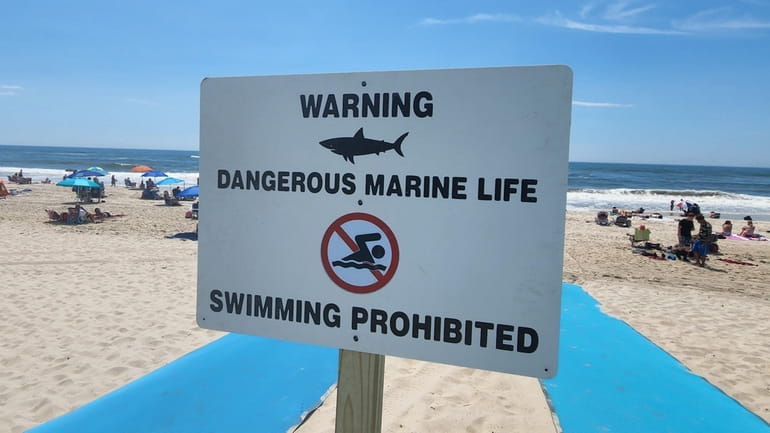DEC: Don't panic, more sharks off Long Island beaches a good sign

Shark bites and sightings have temporarily closed several Long Island beaches this summer but state officials said Monday that attacks are still rare and more sharks are a sign of better overall ocean health. Credit: James Carbone
Of the 13 documented shark attacks on humans in New York over the past century, five have occurred this summer off Long Island’s South Shore, state marine officials said Monday.
They insisted swimmers are not generally in danger of falling victim to a fatal shark attack, but always run the risk of being bitten, though attacks are rare.
“We may see an increase in that going forward … but the sharks that are in the surf are not these large scary things that you see on Shark Week sometimes that are really going to maybe cause a mortality,” said Jim Gilmore, the state Department of Environmental Conservation director of marine resources. “And we’ve never had a mortality in New York in our history.”
As sharks increasingly lurk closer to Long Island’s oceanfront in unprecedented numbers, state officials said in a Monday Zoom call with news reporters, they also are likely swimming in the Great South Bay and other bodies of water connected to the Atlantic Ocean through inlets.
Don't be alarmed, the experts said. Sharks have found their way into inland waters for centuries and are mostly juveniles that pose little threat to humans.
“There is scientific evidence that the sharks in New York are using our estuaries,” said Chris Scott, a marine biologist with the DEC, and described by the agency as the top shark expert in the state.
“Typically it is the juvenile stages of the sharks," he said. "They come in for protection. There is plenty of food in the bays. And they’ll sit there and they’ll stay there throughout the summer and migrate out in the fall.”
He added: “They’ve been there for hundreds of years and there’s been zero incidents in the bays.”
The officials also said that despite a great white shark washing up dead on the beach in Quogue last week, generally, the so-called man-eaters actually pose little danger to humans.
The movie “Jaws,” they said, was just that — a movie.
“It’s been confirmed through scientific studies that white sharks, juvenile white sharks particularly, use New York waters as nursery habitat,” Scott said. “And these animals feed primarily on small fish. They don’t feed on mammals. They certainly don’t want anything to do with humans.”
Five people bitten by sharks off Long Island beaches since late June might disagree.
Shark attacks have occurred off Smith Point, Jones Beach, Ocean Beach and Kismet. Beachgoers, lifeguards, police — sometimes using drones, personal watercraft, even helicopters — have reported numerous shark sightings. Officials have closed down some beaches for hours or even a day at a time.
Those injured have received at most several stitches — but more than a bit of a scare.
The marine experts said it is all a part of a new reality on Long Island due to cleaner waters and a big jump in the bait fish that sharks and others including dolphins, seals, whales and striped bass, love to consume. The bait fish, Atlantic Menhaden, or more commonly, bunker, are sometimes visible in schools by the millions and two miles long. Typically trailing close behind for a meal are sharks or other fish and ocean mammals.
The bunker fish have emerged in huge numbers because of a multistate effort to clean up the ocean and other bodies of water, Gilmore said. Warmer waters are also attracting the sharks and more fish farther north.
It is “overall good news for the marine environment and our ecosystem,” Gilmore said. “However, with that we have had increased interactions between humans and sharks, particularly in the last year and this year in particular.”
Scott said, “This summer is unique, yes, but long-term, we don’t know where we sit as far as moving forward.”
He called sharks “a keystone species that regulate the species diversity, abundance and distribution” of the marine habitat.
“It’s a really positive sign that we are seeing these animals in our waters," Scott said. "New York’s ocean beaches are part of a wild habitat just like, say, if you went into the woods in Alaska, you might see a bear. You go into the ocean here on Long Island, you might interact with a shark.”
Not all bathers are thrilled about that, as they wade cautiously into the ocean, or don’t go in at all. Others say they are unperturbed by the new abundance of sharks.
The state DEC officials said bathers need to take new precautions that most never thought about: swimming in groups to reduce the chance of sharks misidentifying you as bait, not swimming in early morning, dusk or night — prime shark feeding times — and staying out of the water if large schools of bait fish appear nearby or people are fishing. They also said to swim near lifeguards and never in murky waters.
There's no need to shut down a beach every time a shark is spotted, they said. It all depends on factors like whether sharks or the bait fish are close to shore.
In the end, they don’t expect shark encounters here to be deadly — or severe when they happen.
“It’s often a misidentification by the shark bumping into these individuals,” Scott said. “These sharks usually bite and leave the scene. They’re not coming back after the individual.”
2 more body parts suspects in court ... Gilgo-related search ... LI student hit by dirt bike ... Culinary trip to Queens
2 more body parts suspects in court ... Gilgo-related search ... LI student hit by dirt bike ... Culinary trip to Queens
